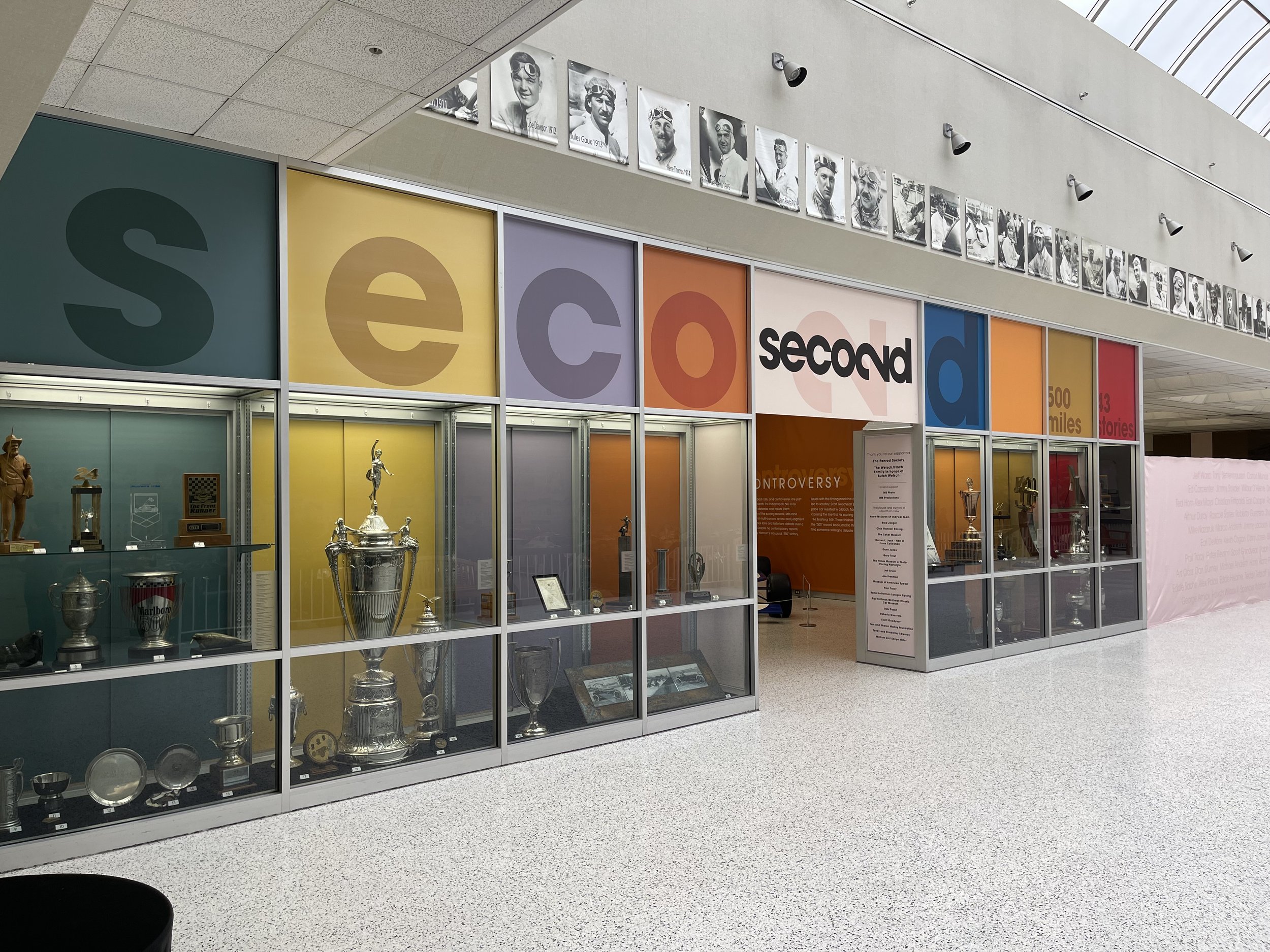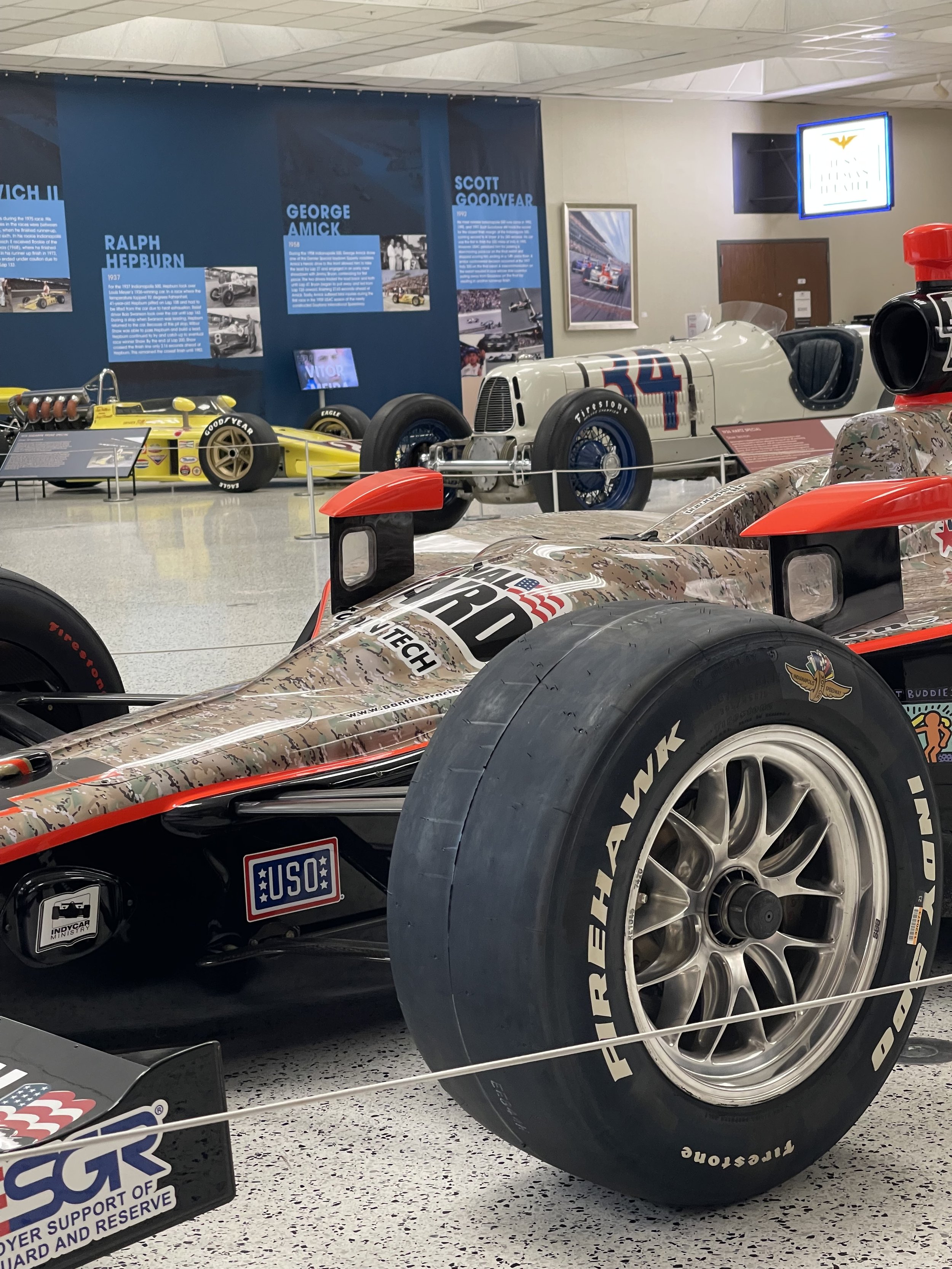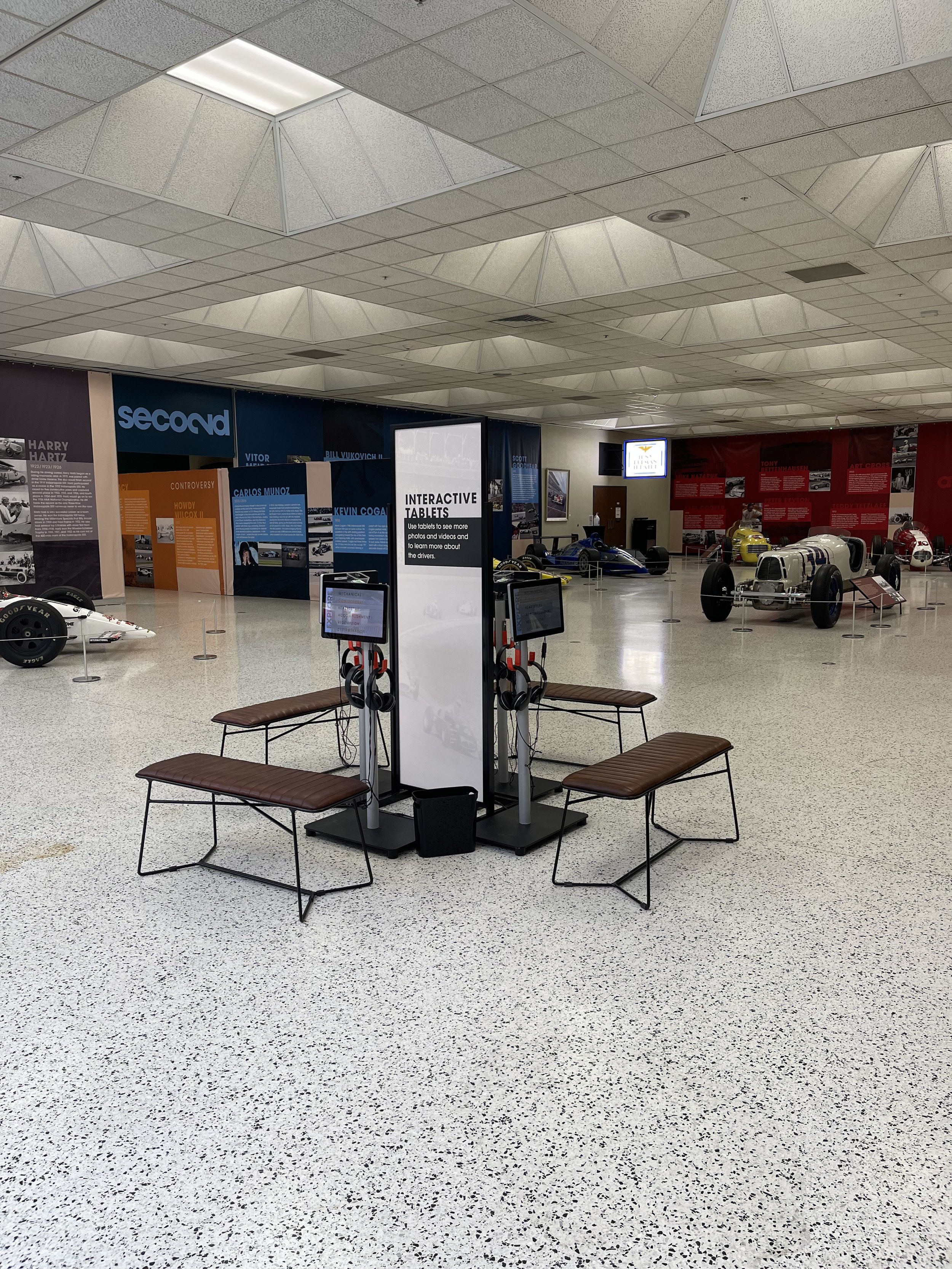Time for a second look: an interview with the Indianapolis Motor Speedway Museum’s Jason Vansickle
The Marmon Wasp in the Indianapolis Motor Speedway Museum
At the Winner’s Gallery of the Indianapolis Motor Speedway Museum, you’ll see the Marmon Wasp, the winning car in the first Indy 500 race, side-by-side with much more contemporary race cars. You’ll also see photographs of all the winners along the back wall, dating from 1911 all the way through 2022.
Historical exhibits will give you a perspective on how much things have changed on the race track, and the infield, since its early days.
But the museum is, according to Vice-President of Curation and Education Jason Vansickle, much more than a race car showroom. The temporary exhibitions might give you some insight into the personalities of the race car drivers. Or they might teach you something about the art of car design.
You can also take part in IMS Museum events such as Indianapolis Cars & Coffee on April 8 where you can munch on donuts and down cups of coffee while checking out cars that collectors and enthusiasts drive onto the grounds.
I talked with Vansickle on Thursday, March 30, via Zoom. The transcript has been edited for clarity and content.
Above images by Luke Edwards, courtesy of IMS Museum.
Indy Correspondent: So maybe you can start by talking about your role as vice president of curation and education.
Vansickle: I've been at the museum in some capacity since 2011. I actually started when I was an undergrad as a tour guide host. And then in 2013, I was hired full time and then since then, I've moved my way through different roles in the kind of curatorial and selection sphere here at the museum. Then recently, in 2021, I was promoted title-wise to vice president of curation and education. So in a short nutshell, that’s kind of my history here.
Indy Correspondent: Have you always been a racing fan?
Vansickle: I would say that I’ve been more of an automotive fan. My father and grandfather were hot rodders, growing up, as a hobby. So I've been around classic cars or automobiles from a very young age, going to car shows and just being around it. So naturally being from Indianapolis and how much the speedway is a cultural icon here, growing up I, obviously, would be drawn to this place.
Inside the IMS Museum
Indy Correspondent: I was really struck by walking in and seeing all these vehicles from different eras on the same floor and particularly the Marmon Wasp, which was the first vehicle to cross the finish line in the first 500 race in 1911. Have you always been able to come into the museum and see all those cars on the same floor?
Vansickle: Yes, we have a mix of permanent and temporary exhibitions. Over the last 10 years we've really delved into that temporary exhibition to tell more stories. But when the museum was founded in 1956, it started as a relatively, in today's terms, small display of 12 vehicles and … they wanted to show three cars from each decade. Up to that point, it was about 40 years [from the first 500 race] when it opened in 1956. So, I think that diversity when it comes to the age of vehicles and the breadth of the collection has been there since the beginning. The Marmon has been on display since 1956 in some capacity, but yeah, you can really look through and not only in the winners section where the Marmon is but in other areas. Just the art collection, in general, you can see that breadth of history.
Indy Correspondent: Then you have all the winning drivers along that wall. It looks like you're getting close to running out of space for those guys. So you got to figure something else out, right?
Vansickle: I remember being here and seeing that timeline … around 2012, 2013 to what it is today and trying to kind of go back and look at that board and say oh man, it's already been 10 years. It’s flown by but I think we were striving for larger plans. So hopefully that timeline in itself is just an example of a larger plan that we have and we're working for it.
Indy Correspondent: I saw that one of your things the museum is directly involved in if I'm not mistaken is Indianapolis Cars & Coffee on April 8. Is that something you guys are organizing?
Vansickle: It's the second Saturday of the month from April through October. It's a free event, excluding the months of May and August because those fall under race events… We're working with Graham Ray Hall performance, partnering with them. It’s really a way for auto enthusiasts to meet and start their day off with some coffee and doughnuts from our partners and talk about cars.
Indy Correspondent: Okay, so even if you don't have a really great vehicle, even if it's just, you know, run of the mill, you can just come in and hang out and have some coffee and donuts and look at some cars.
Vansickle: You can either park in the designated Cars & Coffee area or outside it, but that's something that we've tried to strive for and tell people that you know it's not a car show. It's not a judged event you don't you don't have to have a pristine bar or an exotic car or supercar or muscle car. It's really for the enthusiast, people who love the automobile and want to hang out with like-minded individuals even if it's not your favorite make or model or type of car. That unity thread of passion for the automobile; that's that's what we want to highlight.
Indy Correspondent: So temporary exhibitions. Do you have anything that you're working on that's coming up?
Vansickle: Yeah, actually, we have one that we've announced on social media. It's called Our collection, Your Favorites. We announced it at the beginning of the month. We highlighted 30 vehicles on our social media channels, we wanted the fans and guests to almost guest curate their own exhibition. So out of those 30 cars, the top 15 vote-getters will be on display. So it's a way to have more community participation through social media channels. The voting for that end[ed] on the 31st. So that's something new for us and we're looking forward to that aspect of it. We have another exhibit that will open concurrently that we haven't announced yet so I have to keep that a little quiet. But hopefully in the next few weeks we'll announce that. But both of those exhibits will open in late June and they won't replace our Seconds exhibition that is currently up right now.
Indy Correspondent: So the first exhibition you talked about whatever the fans favorite, oh will be will be highlighted on the floor?
Vansickle: Yeah, and then some additional from our collection that are not vehicles. The display cases will highlight those also, but the votes are mainly on the vehicles.
Indy Correspondent: So in the past 10 years, what has been the biggest change in the museum under your curatorship you think?
Vansickle: I think there's been a variety of different projects and activities here. I think one of the main things is almost a reinvigoration of the museum. For the longest time, the museum was a static entity, really looked upon more as a showroom, if you will. Really nothing changed display-wise or cars on the floor. If people showed up—just an example—people showed up in 2004 and then showed back up in 2005. There may be a car that would change but the overall look and feel of the museum was the same and really stopped that desire for local people to visit the museum. We're still fortunate enough to have a lot of international and interstate travelers and guests come through here but that local audience really changed. So it really started in 2011, and really kicking off in 2016 forward, this idea of temporary exhibitions, and multiple temporary exhibitions to not only be fresh in the museum from a look and feel, but also tell more stories. Last year alone we had five exhibitions open in one year. And they range the gauntlet of historical exhibitions.
We had an art exhibition entitled Sleek: The Art of the Helmet in which we had the 18 Collective member Amiah Mims guest-curate and it looked into the artwork of the helmet. We worked with the Indy Arts Council to select nine local artists to design their own helmet. Obviously Traditions opened last year, Second, which is now open, it opened towards the tail end of 2022 and will be open through the month of May. So all those exhibitions in their own right have a totally different look and feel and theme and that's one of the big threads on top of that too.
We are working towards really some of what we would consider our core documents; the museum's mission, vision, scope of the collection. We tried to look and develop that and understand where we want to go in the future. And with that, obviously there was some deaccession of vehicles and items that really didn't fit our scope. They were outside like non-Indiana-built passenger cars or or non Indy 500 race cars. They really were great to have but we looked at that and they weren't promoting our mission and with the funds realized from the sale of those assets ... We were able to go back into our collection and invest in our restoration department and things like that. So I think that those are all setting up momentum for future plans that we have, and hopefully a modern interpretation of the museum and storytelling that is on par with the 500 or the Indianapolis Motor Speedway.
Indy Correspondent: If you had to recommend one particular story in the Second exhibition for guests to check out what would that be?
Vansickle: It's our largest exhibition from a driver's standpoint, there are 43 drivers to finish second in the 500 and to never win. Obviously there's other drivers who finished second, but they ended up winning. The overall exhibition range is from 1911 all the way until 2022 With Pato [O'Ward] finishing second. And you look at these names and you look at the accomplishments not only make running the Indianapolis 500 an accomplishment in itself and years of what we now call ladder series success will get you into the opportunity to try to make the race. But the fact that it's so difficult to win here at Indianapolis; you have to have so many things go right for you whether skill, the driver, the car prep, the conditions, things that you as a driver you cannot control lead to that victory. You have people like Dan Gurney, Ralph Mulford, Vitor Meira, drivers that are very accomplished in their own right. Whether they be IndyCar champions or like in the case of Dan Gurney, he won multiple Formula One races, but never had a chance to drink the milk in victory lane.
Michael Andretti is another heartbreak. How many how many times; he had the race in the bag as a driver and either mechanical problems or some or some other issue prevented him from winning, obviously, in 1991 that late race drama with him and Rick Mears and him making the pass on the outside … and the following, following lap Mears almost carbon copy passed him on the outside. All these things compile into the art our main theme of just how difficult it is to win Indianapolis in highlighting these 43 drivers.
Indy Correspondent: Well, sometimes it's not a matter of seconds like winning, it's like fractions of a second. So there's almost a double meaning to that right?
Vansickle: Spencer Wishart was 13 minutes behind Jules Goux in 1913 and that's obviously the largest but the closest which still holds today it's Scott Goodyear in 1992 with a 43/1000 of a second difference between him and then winning. So it does kind of have a bit of a double meaning.
Indy Correspondent: One thing I had fun with was the simulator. Have you ever qualified?
Vansickle: Yeah, actually, we had to update some of the components over the last few weeks. I had to make sure that I still had the chops to qualify, so sometimes I'll get on it from time to time.
Indy Correspondent: So yeah, it takes a little practice. You quickly learn that you can't turn too abruptly. You’ll crash into the wall.
Vansickle: Obviously, there's no way to recreate what the drivers have. To string four laps together with limited downforce and speeds of over 232 miles an hour but it does kind of give you a little bit of the nuance and [the feeling that] it could go wrong for you in a second with one relatively minor move of the wrist.





